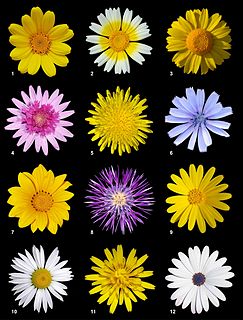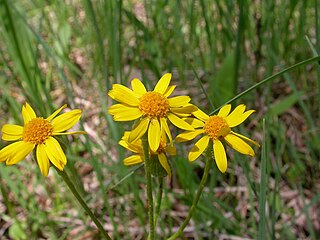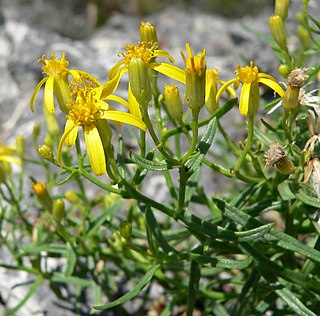
The family Asteraceae, alternatively Compositae, consists of over 32,000 known species of flowering plants in over 1,900 genera within the order Asterales. Commonly referred to as the aster, daisy, composite, or sunflower family, Compositae were first described in the year 1740. The number of species in Asteraceae is rivaled only by the Orchidaceae, and which is the larger family is unclear as the quantity of extant species in each family is unknown.

Senecio is a genus of flowering plants in the daisy family (Asteraceae) that includes ragworts and groundsels.

Senecio vulgaris, often known by the common names groundsel and old-man-in-the-spring, is a flowering plant in the family Asteraceae. It is an annual herb, native to Europe and widely naturalised as a ruderal species in suitable disturbed habitats worldwide.

Packera obovata, the roundleaf ragwort or spoon-leaved ragwort, is an erect perennial herb native to Eastern North America. It was previously called Senecio obovatus. Basal and lower leaves are obovate with toothed margins, while upper leaves are pinnately divided. The ray flowers are yellow and the disk flowers orange-yellow, the inflorescences being held well above the foliage.

Bedfordia is a genus of flowering plants belonging to the family Asteraceae. The genus includes 3 species, all endemic to Australia.
Banksia seneciifolia is a species of column-shaped shrub that is endemic to the south-west of Western Australia. It has linear, pinnatifid leaves, yellow flowers in heads of about twenty-five, and narrow egg-shaped follicles.

Senecio ampullaceus, also known as Texas ragwort, Texas squaw-weed, Texas groundsel, and Texas butterweed, is a species of Senecio in the family Asteraceae, receiving its Latin name ampullaceus from its flask shaped flower-head. It is recommended for landscape use in its native Texas.

Senecio flaccidus, formerly recorded as Senecio douglasii, member of the daisy family and genus Senecio also known as threadleaf ragwort, is a native of the southwestern Great Plains of North America.

Senecio congestus, also known by its common names swamp ragwort, northern swamp groundsel, marsh fleabane, marsh fleawort, clustered marsh ragwort and mastodon flower, a herbaceous member of the family Asteraceae and the genus Senecio, can be seen most easily when its bright yellow umbel flowers appear from May to early July standing 3 to 4 feet along marshes, stream banks and slough areas where it likes to grow.

Senecio angulatus, also known as creeping groundsel and Cape ivy, is a succulent flowering plant in the family Asteraceae that is native to South Africa. Cape ivy is a scrambling and a twining herb that can become an aggressive weed once established, making it an invasive species. It has been naturalised in the Mediterranean Basin, where it is grown as an ornamental plant for its satiny foliage and sweet-scented flowers.

Packera plattensis, commonly known as prairie ragwort or prairie groundsel, is a species of the genus Packera and family Asteraceae. It used to be placed in the genus Senecio.
Carlquistia is a rare North American genus of flowering plants in the family Asteraceae containing the single species Carlquistia muirii. Formerly named Raillardiopsis muirii, the plant was reexamined in the 1990s and moved to a new genus of its own, separate from similar and closely related genera, such as Madia. Common names for the species include Muir's tarplant, Muir's raillardiopsis, and Muir's raillardella.

Senecio hydrophiloides is a species of flowering plant in the aster family known by the common names tall groundsel and sweet marsh ragwort. It is native to western North America from British Columbia and Alberta to northern California to Utah, where it grows in wet meadows and similar habitat. It is a biennial or perennial herb producing a single erect stem or a cluster of a few stems which may exceed one meter in maximum height. The plants are green to red in color and usually without hairs, but new growth can be woolly. The leaves are lance-shaped to oval with toothed edges, the blades up to 25 centimeters long and borne on long winged petioles. The leaves are firm and sometimes a bit fleshy. The inflorescence is a loose or dense cluster of up to 30 or more flower heads lined with black-tipped phyllaries. They contain many yellowish disc florets at the center and often have some yellow ray florets, though these are sometimes absent. Senecio Hydrophiloides can cause Dermatitis.

Senecio integerrimus is a species of flowering plant in the aster family known by the common names lambstongue ragwort and tall western groundsel. It is native to western and central North America, where it grows in grassland, forest, and other habitat. It is a biennial or perennial herb producing one or a few erect stems 20 to 70 centimeters tall from a caudex with fleshy shallow roots. The linear to lance-shaped or triangular leaves are primarily basal, with blades up to 25 cm (10 in) long. The herbage is slightly hairy to woolly or cobwebby. The inflorescence bears several flower heads in a cluster, the middle, terminal head often largest and held on a shorter peduncle, making the cluster look flat. The heads contain many disc florets and usually 8 or 13 ray florets which may be yellow to cream to white in color. Some heads lack ray florets.

Senecio spartioides is a species of flowering plant in the aster family known by the common name broom-like ragwort. It is native to the western United States as far east as the Dakotas and Texas, and northern Mexico. It can be found in dry, rocky, often disturbed areas in a number of habitat types. It is a subshrub which can exceed a meter in height, its arching stems growing from a woody-topped taproot. The leaves are linear in shape and up to 10 centimeters long. The leaves usually have smooth, unlobed edges, but slightly lobed leaves are seen at times. The leaves are evenly distributed along the stems, the ones low on the stems withering away early, giving the plant a naked appearance on the lower half while the top is still lush green and blooming. The inflorescences are spreading, flat-topped arrays of many cylindrical flower heads. The heads contain yellow disc florets and generally either 5 or 8 ray florets each about a centimeter long.

Hasteola suaveolens, known by the common names false Indian plantain and sweet scented Indian plantain, is a perennial forb native to the northeastern and north-central United States. It is found from Massachusetts south to Virginia and North Carolina, and west as far as Minnesota and Minnesota and Missouri.

Leucospermum muirii is a rounded, upright, evergreen shrub of about 1½ m (5 ft) high, with a single trunk at its base, that is assigned to the Proteaceae. The flowering branches are 2–3 mm (0.079–0.118 in) thick and are initially grey due to a covering of fine crinkly hairs, which are soon lost. The very narrow spade-shaped leaves of about 5 cm (2 in) long and ¾ cm (0.3 in) wide carry three to seven teeth, and also quickly lose their soft layer of hairs. Its smallish globe-shaped flower heads of 2–3 cm (0.8–1.2 in) in diameter occur with one to four together, each on a stalk of 1–2 cm (0.4–0.8 in) long. It has pale to greenish yellow flowers, becoming orange with age, with some long hairs near their tips, from which straight styles stick out. This gives the flower head the likeness of a pincushion. It flowers from July till October and is pollinated by birds. It is called Albertinia pincushion in English and bloukoolhout in Afrikaans. It is an endemic species that can only be found near Albertinia in the very south of the Western Cape province of South Africa.

Curio is a genus of flowering plant in the family Asteraceae. Plants in the genus are evergreen succulents with long, striated leaves and discoid flower heads lacking ray florets.
Senecio sarcoides is a species of succulent flowering plant in the aster family, indigenous to the Western Cape and Northern Cape, South Africa.
Leucadendron muirii, the silver-ball conebush, is a flower-bearing shrub that belongs to the genus Leucadendron and forms part of the fynbos. The plant is native to the Western Cape, where it is found on the Elim, Bredasdorp and Riversdale plains. The shrub grows to 2.0 m in height and bears flowers from November to December.
















